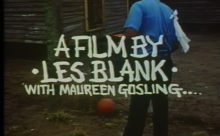Music in the Film
Bois Sec Ardoin, his sons, and Canray Fontenot performed a dynamic pre-zydeco Creole style of music popularized in the 19th century. According to Chris Strachwitz in his notes to the CD La Musique Creole:
In the19th century, a "dance band" in this region was often just a lone fiddler. By the early part of the present [20th] century the accordion had become very popular, and today the almighty "squeezebox" has just about retired most fiddlers, except in white Cajun bands. In the 1960s and 70s, however, the fiddle and accordion still had a marvelous interplay and were just about of equal importance in Creole music.
-From CD notes by Chris Strachwitz. La Musique Creole. Alphonse "Bois Sec" Ardoin with Canray Fontenot. Arhoolie 445. 1966, 1974, and 1996.
Although not zydeco, this traditional Creole music of the rural, mostly French-speaking African American population of southwest Louisiana was a clear antecedent of the contemporary zydeco sound. Nick Spitzer describes the evolution of zydeco in his notes to Zodico: Louisiana Creole Music:
The word zodico is thought in local etymology to be a creolized form of the French les haricots. Hence, the genre of music is said to take its name from a dance tune in both Cajun and Creole traditions called "Les Haricots Sont Pas Salés" ("The Snapbeans Aren't Salted").…Alternate spellings are zorico, zordico, zologo, and zydeco.…
Zodico refers to the fast, syncopated dance numbers in a Creole band's repertoire as well as to the dance event itself.…In a dance setting within the Creole community, zodico musicians usually choose fewer waltzes and more blues and fast two-steps than Cajun musicians.
Nearly all Cajun groups are likely to use the violin as part of the Acadian inheritance while only the old-time and rural zodico bands may have violins (The Carriere Brothers, The Ardoin Brothers, The Lawtell Playboys). Urban bands rarely have violins. Both urban and rural zodico groups use the vest frottoir (rubbingboard played with spoons, beer can openers, or thimbles), but it is rarely found among Cajun bands. The Cajun bas trang or 'tite fer (triangle) is, however, often used by Creole musicians.…
The accordion in both zodico and Cajun music is generally thought to be a German introduction to the area in the 1870s. The traditional model, and the one made by a number of local accordion craftsmen, is the une rangée (one range) diatonic push-pull instrument. It is used by Cajuns and most rural and old-time zodico musicians. Urban performers have experimented with the two- and three-row button accordion as well as the chromatic piano accordion.
Cajun music and zodico are meant for dancing.…Performance of both of these types of Louisiana French music in a club setting is usually highly amplified since the essential requirement is providing music for dancing. As such, the lyrics are often difficult to hear above the music or noise of the club. In general, it can be said that the texts to the dance music of French Louisiana are not as elaborate as those found in the home singing traditions. They are often fragmentary, produced formulaically in performance, and tend to convey "feeling" rather than a story.
Creole culture remains strongest in the countryside, and it is here that the dance hall is still an essential social institution. Men and women come to dances well-dressed in sport coats and ties, pantsuits, carefully set hair, and jewelry. At a rural dance hall like the Ardoins' Club Morris in Duralde, entire families from children to grandparents come to dance.…Zodico is also performed at church dances, barbecue picnics, occasional fais-do-dos (house dances), and in a variety of urban clubs…
From album notes by Nick Spitzer. Zodico: Louisiana Creole Music. Rounder Records 6009, 1976. A CD version of the 1976 LP is currently under preparation as Zydeco Roots.
